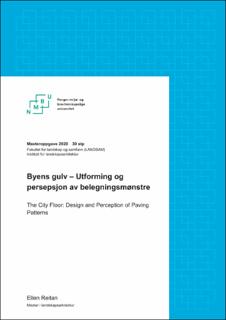| dc.contributor.advisor | Lunde, Kirsten Grindaker | |
| dc.contributor.author | Reitan, Ellen | |
| dc.date.accessioned | 2020-09-08T07:35:04Z | |
| dc.date.available | 2020-09-08T07:35:04Z | |
| dc.date.issued | 2020 | |
| dc.identifier.uri | https://hdl.handle.net/11250/2676788 | |
| dc.description.abstract | Denne oppgaven omhandler det harde bylandskapet med fokus på belegningsmønstre på byens gulv. De er ofte et resultat av funksjonelle betraktninger, men kan også organisere rommet estetisk. Gjennom tiden har det utviklet seg en rekke tradisjonelle belegningsmønstre, men det finnes ingen normer for hvordan belegningsmønstre skal utformes. Denne oppgaven undersøker derfor hvilke faktorer landskapsarkitekten bør ta stilling til ved utforming av belegningsmønstre på plasser, gater og torg. I en tid hvor det er et nasjonalt mål at flere skal gå mer, er fotgjengerens perspektiv trukket inn. Oppgaven undersøker derfor hvilken betydning landskapsarkitektens valg av utforming får for belegningsmønsterets egenskaper og for fotgjengerens opplevelse av det. Temaet belyses teoretisk fra flere hold, hvor litteratur om belegningsmønstre innen landskapsarkitektur sammenstilles med kunnskap om mønstre fra tekstilfaget, samt litteratur som angår fotgjengeren. På bakgrunn av dette utledes det fem kategorier som inneholder faktorer landskapsarkitekten bør ta stilling til ved utforming av belegningsmønstre. Videre presenteres en eksempelstudie hvor gulvet i fire ulike byrom i Oslo er gjenstand for vurdering ut fra et skåringssystem som er utledet av kategoriene. Avslutningsvis diskuteres forskningsspørsmålene opp mot teorien, utledningen av de fem kategoriene og funn gjort i eksempelstudien. Oppgaven konkluderer med hvilke faktorer landskapsarkitekten bør, men ikke nødvendigvis må, ta stilling til ved utforming av belegningsmønstre. Eksempler på dette er mønstertype, mønsterkategori og materialvalg. Undersøkelsen av de fire bygulvene i Oslo viser at valg av utforming blant annet får betydning for belegningsmønsterets kompleksitet og avlesningstid. Likeledes viser de også hvor stor betydning skalaen på mønsteret har for opplevelsen. For å kunne si noe mer allmenngyldig om belegningsmønstrenes egenskaper og fotgjengerens opplevelse av disse konkluderes det med at det bør gjøres en større feltstudie av belegningsmønstre på gater, plasser og torg, ikke minst fordi persepsjon og opplevelse er subjektivt. Betydningen av belegningsmønstres egenskaper og fotgjengeres opplevelser av disse bør trolig gis en mer sentral plass i landskapsarkiteturfaget, samt ha et større fokus gjennom utdannelsen ved NMBU. | en_US |
| dc.description.abstract | This thesis examines the hard urban landscape with a focus on city floor paving patterns. They are often the result of functional considerations but can also organize city space aesthetically. Over time, several traditional paving patterns have emerged, but there are no norms for how paving patterns should be designed. This thesis therefore examines the kinds of factors the landscape architect should consider when designing paving patterns for public spaces, streets and squares. At a time when there is a national goal that more people should walk more, the pedestrian’s perspective comes into play. The thesis therefore examines what significance the landscape architect’s choice of design has for the characteristics of the paving patterns and for the pedestrian’s experience of them. Several aspects of this topic are looked at theoretically, drawing on literature on paving patterns in landscape architecture and knowledge about patterns within the textile profession, as well as literature on pedestrian perception. Based on this, five categories have been derived as to what factors the landscape architect should consider when designing paving patterns. Furthermore, a case study is presented where the floors of four different urban spaces in Oslo are evaluated using a scoring system based on the categories. Finally, the research questions are discussed relative to the theoretical literature, the derivation of the five categories and the findings of the case study. The thesis concludes with factors the landscape architect should consider when designing paving patterns. Examples of this are the type of pattern, the pattern category and the choice of paving material. The study of the four city floors in Oslo shows that the choice of design, among other things, has an impact on the complexity of the paving pattern and the time it takes to be perceived. It also shows how important the scale of the pattern is for its perception. To be able to say something more general about the characteristics of the paving patterns and the pedestrian experience of these, a larger study of paving patterns in streets, public places and squares should be done, especially because perception and experience are subjective. The importance of the characteristics of paving patterns and the pedestrian perception of them should probably be given a more central place in the landscape architecture profession, as well as a greater focus in the curriculum at NMBU. | en_US |
| dc.language.iso | nob | en_US |
| dc.publisher | Norwegian University of Life Sciences, Ås | en_US |
| dc.rights | Attribution-NonCommercial-NoDerivatives 4.0 Internasjonal | * |
| dc.rights.uri | http://creativecommons.org/licenses/by-nc-nd/4.0/deed.no | * |
| dc.subject | Belegg | en_US |
| dc.subject | Belegningsstein | en_US |
| dc.subject | Mønster | en_US |
| dc.subject | Naturstein | en_US |
| dc.subject | Tegl | en_US |
| dc.subject | Betong | en_US |
| dc.subject | Byrom | en_US |
| dc.subject | Fotgjengere | en_US |
| dc.title | Byens gulv : utforming og persepsjon av belegningsmønstre | en_US |
| dc.title.alternative | The city floor: design and perception of paving patterns | en_US |
| dc.title.alternative | The city floor : design and perception of paving patterns | en_US |
| dc.type | Master thesis | en_US |
| dc.description.version | submittedVersion | en_US |
| dc.source.pagenumber | 158 | en_US |
| dc.description.localcode | M-LA | en_US |

